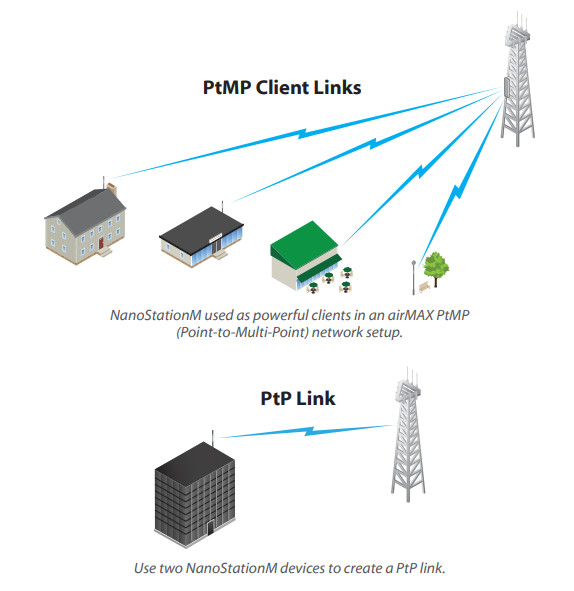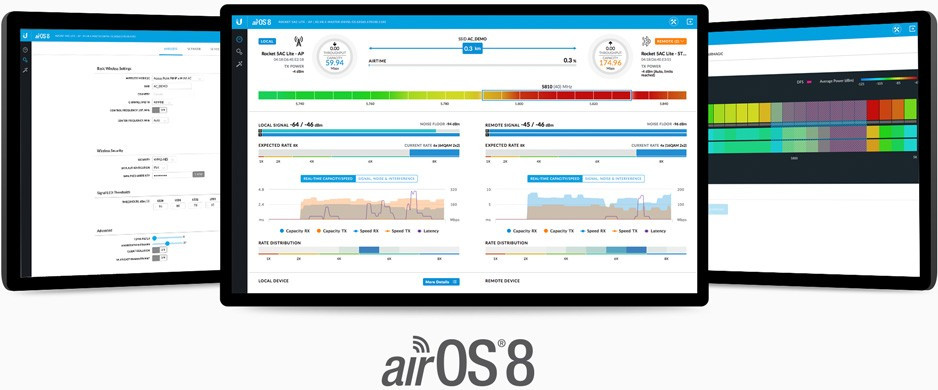Low-cost and efficient broadband 5 GHz CPE with link range 10+ km
The airMAX NanoStation M5 Loco, distinguished by its manufacture part number LOCOM5, epitomizes Ubiquiti Networks’ commitment to providing compact, cost-effective, and powerful wireless broadband solutions. This device is a compact, high-performance model designed for point-to-point (PtP) and point-to-multipoint (PtMP) applications, embodying the technological innovation synonymous with the Ubiquiti brand. The NanoStation M5 Loco utilizes Ubiquiti’s pioneering airMAX technology, which incorporates a Time Division Multiple Access (TDMA) protocol. This protocol enhances network performance by significantly reducing noise and enabling more efficient bandwidth usage, thereby ensuring high throughput rates and low latency across the network.
In a PtP scenario, the NanoStation M5 Loco functions as one end of a wireless link, working in tandem with another LOCOM5 unit or a compatible airMAX device at the opposite end. This setup is ideal for connecting two distant network nodes, extending internet access, or linking two separate networks over a direct wireless bridge. Both units communicate with each other to facilitate data transmission across the link, necessitating precise alignment and configuration to ensure optimal performance. For PtMP applications, the NanoStation M5 Loco can serve as either an access point serving multiple client devices or as a client itself connected to a central access point. In such setups, the LOCOM5 unit integrates into a wider network that includes a central hub—possibly another Ubiquiti device configured as an airMAX sector antenna—and multiple endpoint devices. This configuration expands network coverage or internet access to a broader area, serving multiple users or locations from a single centralized source.
Operating in the 5 GHz frequency band, the NanoStation M5 Loco is engineered to mitigate interference from congested wireless signals in the more commonly used 2.4 GHz range. This capability makes it particularly well-suited for applications in densely populated urban areas where wireless traffic is heavy. The device is capable of delivering speeds of over 150 Mbps, facilitating smooth, high-bandwidth internet connections over considerable distances. This is achieved through its integrated 13 dBi antenna, which amplifies the signal strength, thereby extending the reach of wireless connections to 10+ kilometers under optimal conditions.
The NanoStation M5 Loco features a sleek, compact design that belies its robust functionality. Its small footprint allows for easy mounting on poles, walls, or other surfaces, making it versatile for various deployment scenarios without being obtrusive. Despite its diminutive size, the device is built to withstand harsh outdoor environments, thanks to its durable, weather-resistant construction. This resilience ensures reliable operation even in adverse weather conditions, highlighting its suitability for outdoor wireless communication networks.
Connectivity options on the NanoStation M5 Loco include a single Ethernet port that supports passive Power over Ethernet (PoE). This feature simplifies installation and deployment by allowing both power and data to be delivered through a single cable, reducing clutter and eliminating the need for a separate power source. This is particularly advantageous in remote or elevated locations where power accessibility might be limited.
Ubiquiti’s airOS software powers the NanoStation M5 Loco, providing a user-friendly interface for device configuration and network management. airOS includes advanced features such as device discovery, system status monitoring, and firmware upgrading, as well as tools for network administrators to finely tune the wireless settings. This comprehensive software suite enables optimized network performance and facilitates the management of complex wireless networks.
Application scenarios
The airMAX NanoStation M5 Loco, with its robust wireless capabilities and compact design, finds its utility in diverse scenarios beyond the conventional point-to-point (PtP) and point-to-multipoint (PtMP) configurations. One notable application is in providing wireless backhaul for security cameras in locations where laying physical cables is impractical or too expensive. For example, in large industrial complexes or agricultural farms where monitoring equipment is crucial for operational security and efficiency, the LOCOM5 can wirelessly connect distant surveillance cameras back to a central monitoring station. This setup not only simplifies the installation of security infrastructure across expansive areas but also enhances the flexibility in positioning cameras to optimal vantage points without the constraints of cabling.
Additionally, the NanoStation M5 Loco serves as an ideal solution for establishing temporary internet access in outdoor event venues, construction sites, or emergency response bases. In situations where events are held in remote locations without existing internet infrastructure, or where temporary structures need network connectivity, the LOCOM5 can quickly provide a reliable wireless link to the nearest internet source. This capability ensures that event organizers, construction project managers, or emergency response teams can maintain essential communications, manage online systems, and access cloud resources with minimal setup time and without the need for permanent infrastructure modifications. The device's ease of deployment, combined with its outdoor durability, makes it exceptionally well-suited for these transient yet critical networking needs.
Compare with similar products
| | | | |
|---|
| Wireless Standard | |
| |
| 802.11a/n
| 802.11b/g/n
| 802.11ac
|
| 2.4GHz Radio Rate | |
| |
| 150 Mbps
|
|
| 5GHz Radio Rate | |
| |
| 150 Mbps
|
| 450 Mbps
|
| Wireless Antenna Frequency Range & Gain | |
| |
| 5.170 - 5.875 (GHz) 13 (dBi)
| 2.412 - 2.462 (GHz) 8 (dBi)
| 5.150 - 5.875 (GHz) 13 (dBi)
|
| Antenna beamwidth | |
| |
| 45 °
| 60 °
| 45 °
|
| Ethernet Ports | |
| |
| 1 x 100 Mbps
| 1 x 100 Mbps
| 1 x 1 Gbps
|
| Chipset | |
| |
| Atheros MIPS 74Kc, 560 MHz
| Atheros MIPS 24Kc, 400 MHz
| Atheros MIPS 74Kc, 560 MHz
|
| RAM | |
| |
| 64 MB
| 32 MB
| 64 MB
|
| Storage Memory | |
| |
| 8 MB
| 8 MB
|
|
| Operating Temperature | |
| |
| -30 °C to 75 °C
| -30 °C to 75 °C
| -40 °C to 70 °C
|
| Max Power Consumption | |
| |
| 6 W
| 6 W
| 7 W
|
| Weight | |
| |
| 0.18 kg
| 0.18 kg
| 0.18 kg
|
| | | | |
|---|
| Wireless Standard | 802.11a/n
| 802.11b/g/n
| 802.11ac
|
| 2.4GHz Radio Rate |
| 150 Mbps
|
|
| 5GHz Radio Rate | 150 Mbps
|
| 450 Mbps
|
| Wireless Antenna Frequency Range & Gain | 5.170 - 5.875 (GHz) 13 (dBi)
| 2.412 - 2.462 (GHz) 8 (dBi)
| 5.150 - 5.875 (GHz) 13 (dBi)
|
| Antenna beamwidth | 45 °
| 60 °
| 45 °
|
| Ethernet Ports | 1 x 100 Mbps
| 1 x 100 Mbps
| 1 x 1 Gbps
|
| Chipset | Atheros MIPS 74Kc, 560 MHz
| Atheros MIPS 24Kc, 400 MHz
| Atheros MIPS 74Kc, 560 MHz
|
| RAM | 64 MB
| 32 MB
| 64 MB
|
| Storage Memory | 8 MB
| 8 MB
|
|
| Operating Temperature | -30 °C to 75 °C
| -30 °C to 75 °C
| -40 °C to 70 °C
|
| Max Power Consumption | 6 W
| 6 W
| 7 W
|
| Weight | 0.18 kg
| 0.18 kg
| 0.18 kg
|
Technical Specs / Datasheet



Reviews and ratings
Product rating